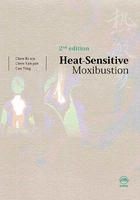
Chapter 2 Manipulation
1 Exploring for Heat-sensitive Acupoints
The first step in HSM is finding heat-sensitive acupoints, which is necessary to achieve a positive therapeutic effect. To do so, one must be familiar with the sensations of heat sensitization, use the proper tools and perform moxibustion correctly. The best tool for heat-sensitive acupoints is suspended moxibustion using a moxa stick. The patient should sit or lie in a quiet room between 20-30 degrees Celsius with the body part to be explored fully exposed. The patient should be asked to relax the muscles, breathe regularly and focus on feeling the sensations at the spot receiving moxibustion.
Heat-sensitized acupoints are places on the body surface that reflect the presence of disease. Directly or indirectly, they reflect a disease’s location, nature and mechanism.Heat-sensitive acupoints appear in different places under various circumstances, and exploration is performed in two steps, rough and precise location.
Rough Location of Heat-sensitive Acupoints
Rough location is the exploration of areas where it is likely that heat sensitization has occurred. These areas depend on the disease. For example, the area likely to be heat sensitized in allergic rhinitis is around shàng yìn táng (上印堂 ); in bronchial asthma it is around BL 13 (fèi shù); and in facial paralysis around TE 17 (yì fēng). Knowing these areas of high probability helps to locate heat-sensitized acupoints accurately.
Precise Location of Heat-sensitive Acupoints
Stimulation by burning moxa can elicit the following six sensations if an acupoint is heat sensitized. The elicitation of these sensations reveals the precise location of the heatsensitive acupoint.
1. Penetrating heat: when the heat received from burning moxa at the surface sinks into the underlying tissues or organs.
2. Expanding heat: when the heat spreads out from the spot receiving moxibustion.
3. Transmitting heat: when heat travels from the spot receiving moxibustion along a certain route, possibly to the diseased site.
4. Distal but not local heat: when the feeling of heat is felt at a site away from the spot receiving moxibustion, with only mild heat felt at the point receiving moxibustion.
5. Deep but not surface heat: when heat is felt in the underlying tissues or organs instead of at the spot on the skin receiving moxibustion.
6. Non-heat sensations: physical feelings other than heat that are felt at or away from the spot receiving moxibustion, such as soreness, distention, pressure, heaviness, pain,numbness and cold.
Precise location of heat-sensitized acupoints is performed using four methods.
Keeping 3 cm between the burning moxa stick and the spot receiving moxibustion,move the stick around the acupoint in a circle.Stop moxibustion when the patient feels heat at the spot or when the spot becomes red. This warms the local qi and blood. (Fig. 2-1)

Keeping 3 cm between the burning moxa stick and the patient’s skin, move the moxa stick back and forth along a channel at an even pace until the patient feels heat along the line and the skin becomes red. This method dredges the channels and unblocks the collaterals to further activate channel qi. (Fig. 2-2)

Like a bird pecking at the ground,move the burning moxa up and down above the skin. This deepens the sensitization of the place receiving moxibustion, laying a foundation for the activation of qi in the area and for channel qi transmission. (Fig. 2-3)

Keeping 3 cm between the burning moxa stick and the acupoint or affected body part,hold the moxa stick above the area until it feels hot but not painful. This further stimulates the channel qi and induces transmission. (Fig. 2-4)

The exploration for heat-sensitive acupoints usually involves a combination of these methods. First, one should use the first three methods, one minute each in sequence until the local skin turns red. Usually this takes two or three rounds. Then apply mild moxibustion, asking the patient to focus on any changes at the place receiving moxibustion. The patient should tell the doctor when any of the six heat-sensitized sensations arises. The spot where such sensations are felt is the precise location of the heat-sensitive acupoint.
In some patients with relatively stable chronic diseases, heat sensitization can be slow to appear. In this case, mild moxibustion can be used to strengthen the acupoints and enhance channel qi in general. The commonly used points include CV 8 (shén què), CV 4 (guān yuán), GV 14 (dà zhuī), BL 23 (shèn shù) and ST 36 (zú sān lĭ). Forty minutes of moxibustion is administered each day, four to six times total. After this is performed, use the above four methods again to explore for heat-sensitized acupoints.